Chapter: Mechanical : Dynamics of Machines : Single Degree Free Vibration
Solved Problems: Single Degree Free Vibration
SOLVED PROBLEMS
1. A
machine of mass 75 kg is mounted on springs and is fitted with a dashpot to
damp out vibrations. There are three springs each of stiffness 10 N/mm and it
is found that the amplitude of vibration diminishes from 38.4 mm to 6.4 mm in
two complete oscillations. Assuming that the damping force varies as the
velocity, determine : 1. the resistance of the dash-pot at unit velocity ; 2.
the ratio of the frequency of the damped vibration to the frequency of the undamped
vibration ; and 3. the periodic time of the
![]()
![]() damped
vibration.
damped
vibration.
Solution.
Given : m
= 75 kg ; s = 10 N/mm = 10 ×103 N/m ; x1 = 38.4 mm = 0.0384 m ; x3 = 6.4 mm = 0.0064 m
![]() Since
the stiffness of each spring is 10 × 103 N/m and there are 3
springs, therefore total stiffness,
Since
the stiffness of each spring is 10 × 103 N/m and there are 3
springs, therefore total stiffness,
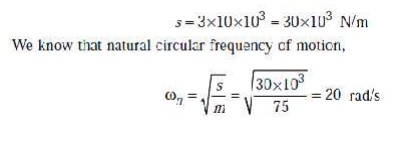
1. Resistance
of the dashpot at unit velocity
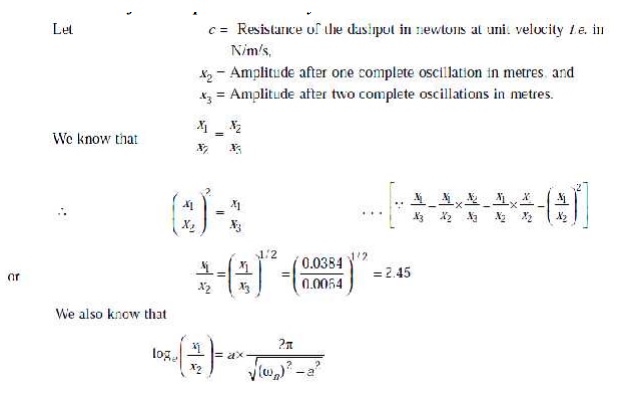
2. Ratio of the frequency of the damped
vibration to the frequency of undamped vibration
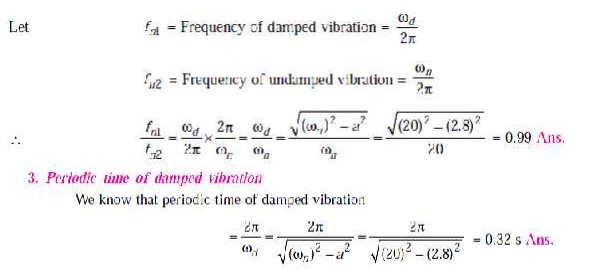
2. The mass of a single degree damped vibrating
system is 7.5 kg and makes 24 free oscillations in 14 seconds when disturbed
from its equilibrium position. The amplitude of vibration reduces to 0.25 of
its initial value after five oscillations. Determine : 1. stiffness of the
spring, 2. logarithmic decrement, and 3. damping factor, i.e. the ratio of the
system damping to critical damping.
![]()
![]()
Solution.
Given : m
= 7.5 kg
Since 24 oscillations are made in 14 seconds,
therefore frequency of free vibrations,
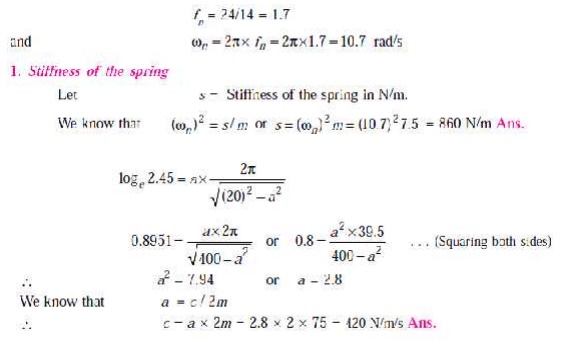

3(i) The measurements on a mechanical vibrating
system show that it has a mass of 8 kg and that the springs can be combined to
give an equivalent spring of stiffness 5.4 N/mm. If the vibrating system have a
dashpot attached which exerts a force of 40 N when the mass has a velocity of 1
m/s, find : 1. critical damping coefficient, 2. damping factor, 3. logarithmic
decrement, and 4. ratio of two consecutive amplitudes.
![]()
![]()
![]()
Solution. Given : m
= 8 kg ; s = 5.4 N/mm = 5400 N/m
Since the force exerted by dashpot is 40 N, and
the mass has a velocity of 1 m/s , therefore Damping coefficient (actual),
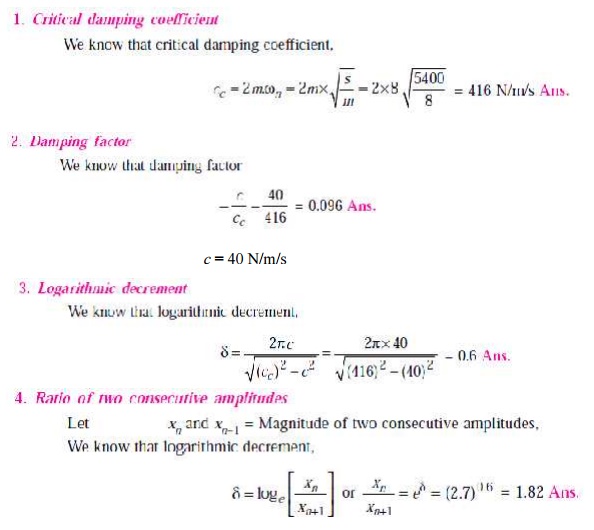
3 (ii) An
instrument vibrates with a frequency of 1 Hz when there is no damping. When the
damping is provided, the frequency of damped vibrations was observed to be 0.9
Hz. Find 1. the damping factor, and 2. logarithmic decrement.
Solution. Given : fn
= 1 Hz ; fd = 0.9 Hz
1.
Damping factor
Let m = Mass
of the instrument in kg,
c = Damping
coefficient or damping force per unit
cc= velocity in N/m/s, and Critical damping coefficient in N/m/s.
We know that natural circular frequency of
undamped vibrations,
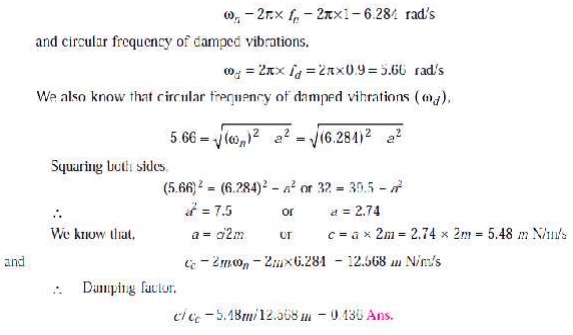
4(i) A coil of spring stiffness 4
N/mm supports vertically a mass of 20 kg at the free end. The motion is
resisted by the oil dashpot. It is found that the amplitude at the beginning of
the fourth cycle is 0.8 times the amplitude of the previous vibration.
Determine the damping force per unit velocity. Also find the ratio of the
frequency of damped and undamped vibrations.
![]()
![]()
![]()
Solution.
Given : s
= 4 N/mm = 4000 N/m ; m
= 20 kg
![]()
Damping force per unit velocity
Let c
= Damping force in newtons per unit velocity i.e. in N/m/s
xn
= Amplitude at the beginning of the third cycle,
xn+1 =
Amplitude at the beginning of the fourth cycle = 0.8 xn We know that natural circular frequency of motion,

4(ii) Derive an expression for the natural
frequency of single degrees of freedom system.
We know that the kinetic energy is due to the
motion of the body and the potential energy is with respect to a certain datum
position which is equal to the amount of work required to move the body from
the datum position. In the case of vibrations, the datum position is the mean
or equilibrium position at which the potential energy of the body or the system
is zero.
In the free vibrations, no energy is transferred
to the system or from the system. Therefore the summation of kinetic energy and
potential energy must be a constant quantity which is same at all the times. In
other words,
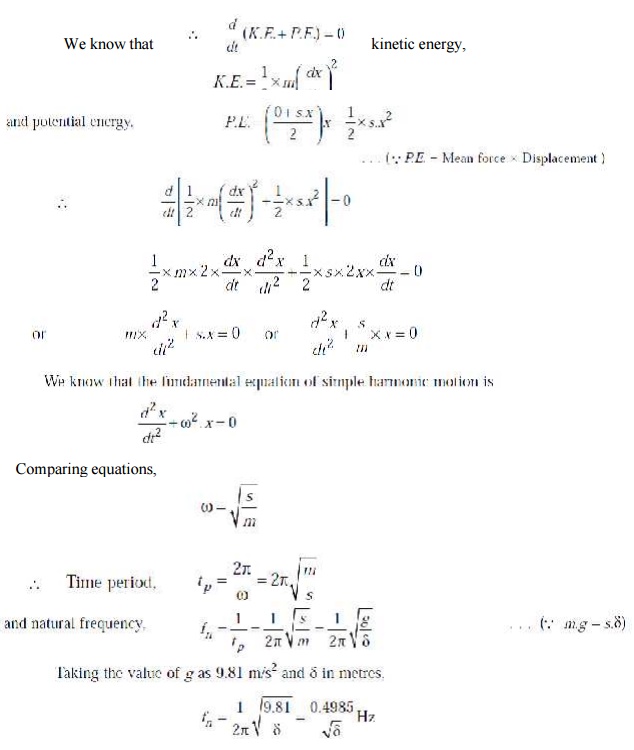
5. A vertical shaft of 5 mm diameter is 200 mm long
and is supported in long bearings at its ends.
A disc of mass 50 kg is attached to the centre of the shaft. Neglecting any
increase in stiffness due to the attachment of the disc to the shaft, find the
critical speed of rotation and the maximum bending stress when the shaft is rotating
at 75% of the critical speed. The centre of the disc is 0.25 mm from the
geometric axis of the shaft. E = 200 GN/m2.
Solution.
Given : d
= 5 mm = 0.005 m ; l
= 200 mm = 0.2 m ; m
= 50 kg ; e = 0.25 mm = 0.25 × 10–3 m ; E = 200 GN/m2 = 200 × 109
N/m2
Critical speed of rotation
We know that moment of inertia of the shaft,

Since the shaft is supported in long bearings,
it is assumed to be fixed at both ends. We know that the static deflection at
the centre of the shaft due to a mass of 50 kg,

Maximum bending stress
Let σ = Maximum
bending stress in N/m2, and
N
= Speed of the shaft = 75% of critical speed =
0.75 Nc . . . (Given)
When the shaft starts rotating, the additional
dynamic load (W1) to which the shaft
is subjected, may be obtained by using the bending equation,

We know that for a shaft fixed at both ends and
carrying a point load (W1) at the
centre, the maximum bending moment
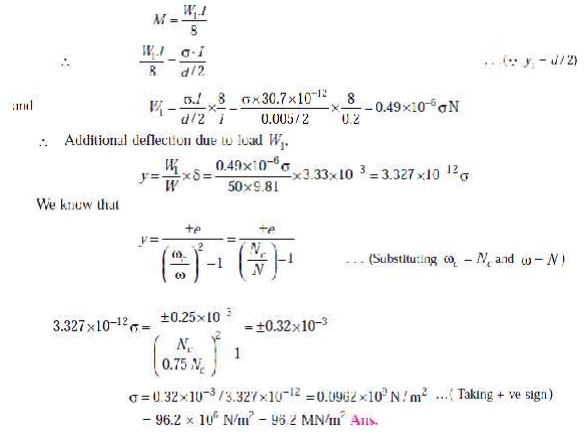
6.(i) A shaft 50 mm diameter and
3 metres long is simply supported at the ends and carries three loads of 1000
N, 1500 N and 750 N at 1 m, 2 m and 2.5 m from the left support. The Young's
modulus for shaft material is 200 GN/m2. Find the frequency of transverse
vibration.
![]()
![]()
![]()
Solution.
Given : d
= 50 mm = 0.05 m ; l
= 3 m, W1 = 1000 N ; W2 = 1500 N ; W3 = 750 N; E = 200 GN/m2 = 200 × 109 N/m2
![]() The
shaft carrying the loads is shown in Fig. 23.13 We know that moment of inertia
of the shaft,
The
shaft carrying the loads is shown in Fig. 23.13 We know that moment of inertia
of the shaft,
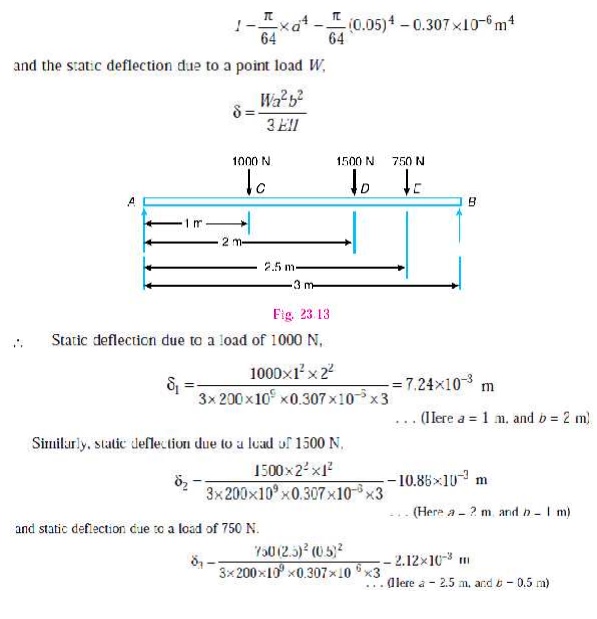

6.(ii) Calculate the whirling speed of a shaft 20
mm diameter and 0.6 m long carrying a mass of 1 kg at its mid-point. The
density of the shaft material is 40 Mg/m3, and Young’s modulus is
200 GN/m2. Assume the shaft to be freely supported.
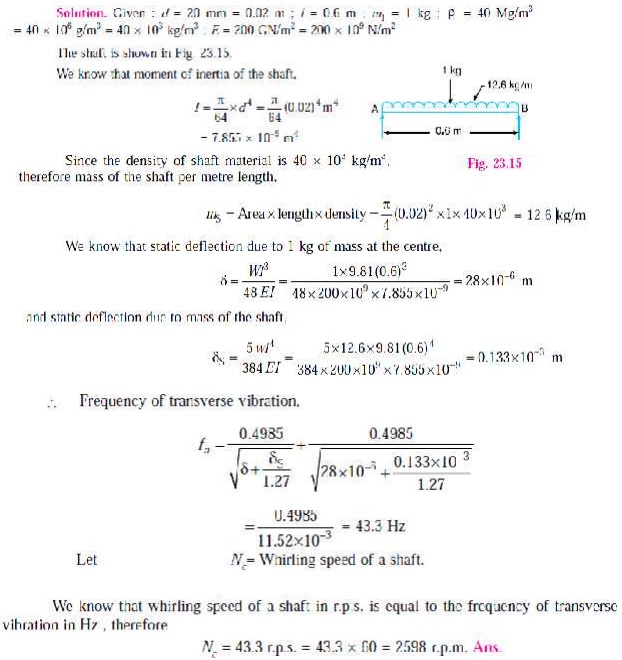
TUTORIAL PROBLEMS
1.
A beam of length 10 m carries two loads of mass 200
kg at distances of 3 m from each end
together with a central load of mass 1000 kg. Calculate the frequency of
transverse vibrations. Neglect the mass of the beam and take I = 109 mm4 and E = 205×10 3 N/mm2.
[Ans. 13.8 Hz]
13.8
2.
A vertical shaft 25 mm diameter and 0.75 m long is
mounted in long bearings and carries
a pulley
of mass
10 kg midway between the bearings. The centre of pulley is 0.5 mm from the axis
of the shaft. Find (a) the whirling
speed, and (b) the bending stress in
the shaft, when it is rotating at 1700 r.p.m. Neglect the mass of the shaft and
E = 200 GN/m2.
[Ans. 3996 r.p.m ; 12.1 MN/m2]
3. A shaft of 100 mm diameter and 1 metre long is
fixed at one end and the other end carries a
flywheel
of mass 1 tonne. The radius of gyration of the flywheel is 0.5 m. Find the
frequency of torsional vibrations, if the modulus of rigidity for the shaft
material is 80 GN/m2. [Ans. 8.9 Hz]
4.The two
rotors A and B are attached to the end of a shaft 500 mm long. The mass of the
rotor A is 300 kg and its radius of gyration is 300 mm. The corresponding
values of the rotor B are 500 kg and 450 mm respectively. The shaft is 70 mm in
diameter for the first 250 mm ; 120 mm for the next 70 mm and 100 mm diameter
for the remaining length. The modulus of rigidity for the shaft material is 80
GN/m2. Find : 1. The position of the node, and 2. The frequency of
torsional vibration. [Ans. 225 mm from A ; 27.3 Hz]
Related Topics